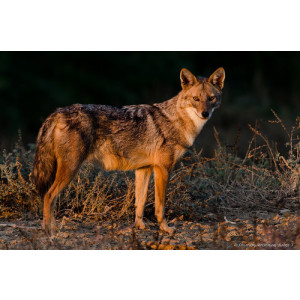Bengal Fox Did you see this animal?
Scientific Name : Vulpes bengalensis
Family : Canidae
Order : Carnivora
Class : Mammalia
Phylum : Chordata
Other Name : Indian fox
Habitat : Shrubland, Grassland
Description : Bengal foxes are small canids, with a body length ranging from 45 to 60 cm and a shoulder height of up to 30 cm. They weigh between 1.5 to 3 kg, depending on their habitat and subspecies.
Their fur color can vary from yellowish-gray to reddish-brown, with a white belly and black-tipped tail. They have a bushy tail, which helps them to balance and communicate with other foxes.
Bengal foxes are highly adaptable and can live in a variety of habitats, including grasslands, scrublands, and agricultural fields. They are primarily nocturnal and solitary, although they may form small family groups during the breeding season.
Their diet mainly consists of small mammals, such as rodents, hares, and birds, but they can also feed on insects, fruits, and carrion. They are skilled hunters and use their keen sense of hearing and smell to locate prey.
Bengal foxes are highly vocal and use a variety of calls, including barks, yelps, and whines, to communicate with each other. They have a strong sense of smell and use scent marking to establish their territory.
Breeding occurs between December and February, and after a gestation period of 50 to 60 days, females give birth to litters of 2 to 4 pups. The young are born blind and helpless and stay with their mother until they are able to hunt and fend for themselves.
Bengal foxes are not considered endangered by the International Union for Conservation of Nature (IUCN), although they are threatened by habitat loss and fragmentation due to human activities.
In conclusion, Bengal foxes are unique and important canid species that play a crucial role in their ecosystems. It is important to protect them and their habitat to ensure their survival and maintain the balance of their ecosystems.
Their fur color can vary from yellowish-gray to reddish-brown, with a white belly and black-tipped tail. They have a bushy tail, which helps them to balance and communicate with other foxes.
Bengal foxes are highly adaptable and can live in a variety of habitats, including grasslands, scrublands, and agricultural fields. They are primarily nocturnal and solitary, although they may form small family groups during the breeding season.
Their diet mainly consists of small mammals, such as rodents, hares, and birds, but they can also feed on insects, fruits, and carrion. They are skilled hunters and use their keen sense of hearing and smell to locate prey.
Bengal foxes are highly vocal and use a variety of calls, including barks, yelps, and whines, to communicate with each other. They have a strong sense of smell and use scent marking to establish their territory.
Breeding occurs between December and February, and after a gestation period of 50 to 60 days, females give birth to litters of 2 to 4 pups. The young are born blind and helpless and stay with their mother until they are able to hunt and fend for themselves.
Bengal foxes are not considered endangered by the International Union for Conservation of Nature (IUCN), although they are threatened by habitat loss and fragmentation due to human activities.
In conclusion, Bengal foxes are unique and important canid species that play a crucial role in their ecosystems. It is important to protect them and their habitat to ensure their survival and maintain the balance of their ecosystems.
Distribution in Bangladesh
References:
description written by:Asad U. Tanvir,Department of Zoology,Jagannath University,Dhaka; reviewed by:Muntasir Akash,Department of Zoology,University of Dhaka;Taxonomic Checklist:Red List of Bangladesh Volume 2: Mammals, 2015, IUCN; information sources:iucnredlist.org, Khan 2018 (Photographic guide to the wildlife of Bangladesh), photo credit:markus lilje(www.inaturalist.org/people/prashanthmb), photo copyright: iNaturalist.more information please contact with us.
description written by:Asad U. Tanvir,Department of Zoology,Jagannath University,Dhaka; reviewed by:Muntasir Akash,Department of Zoology,University of Dhaka;Taxonomic Checklist:Red List of Bangladesh Volume 2: Mammals, 2015, IUCN; information sources:iucnredlist.org, Khan 2018 (Photographic guide to the wildlife of Bangladesh), photo credit:markus lilje(www.inaturalist.org/people/prashanthmb), photo copyright: iNaturalist.more information please contact with us.































